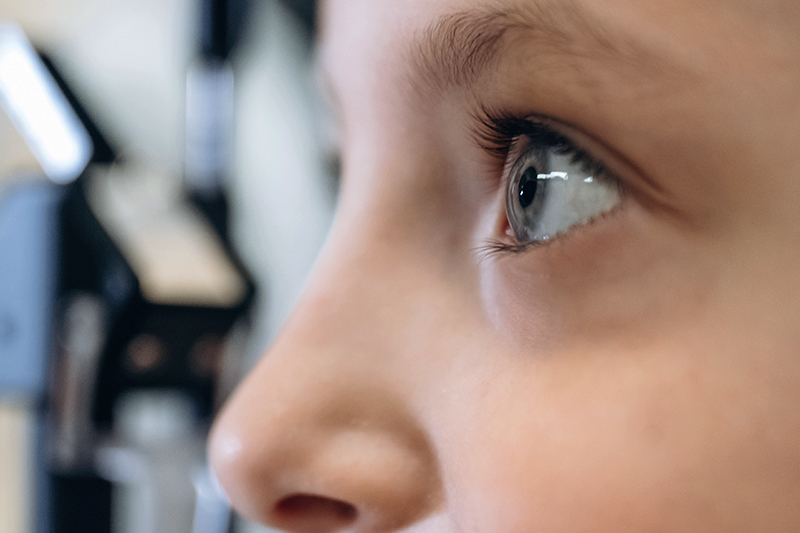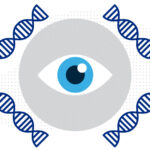New research sheds light on the genetic roots of amblyopia

For decades, amblyopia has been considered a disorder primarily caused by abnormal visual experiences early in life. But new research from Mary Whitman, MD, PhD, pediatric ophthalmologist in the Department of Ophthalmology at Boston Children’s Hospital, and her colleagues suggests the story is more complicated.
“There may be underlying neurodevelopmental differences in children with amblyopia that affect how their brain reacts to the differences in their eyes,” says Whitman.
A new lens on amblyopia
Amblyopia affects about 3 percent of the population and typically develops in childhood when the brain favors one eye over the other, leading to reduced vision that persists into adulthood if untreated. Until now, the condition was largely viewed as the result of disrupted visual input during the brain’s critical period of development.
This research, published in Ophthalmology, is one of the largest genetic studies of amblyopia to date and provides compelling evidence that the condition may have deeper neurodevelopmental roots. The study examined genetic data from over 120,000 participants in the National Institutes of Health’s All of Us Research Program, a diverse biomedical database. The findings suggest that in addition to visual experience, genetics — particularly genes involved in brain development — may play a key role in how amblyopia develops.
Digging into the data
Whitman and her team used two types of genetic analysis to explore the underlying causes of amblyopia: a genome-wide association study (GWAS) to look for common variants, and a rare variant association study (RVAS) to examine gene-level differences. Their goal was to compare the genes of people with and without amblyopia to see how they differ.
In the GWAS, four genetic regions showed suggestive associations with amblyopia. “Each of those is what’s called an ‘expression quantitative trait locus,” Whitman says, “meaning a change at that base pair affects the expression of another gene — and the genes that they influence are involved in neurodevelopment.”
The RVAS identified 15 genes with different numbers of variants in people with amblyopia versus those without. “A number of those genes are neurodevelopmental genes. But they’re not genes associated with eye growth or eye development like we had expected to find,” Whitman explains. “Instead, amblyopia may result from underlying neurodevelopmental differences interacting with abnormal visual experience.”
Transforming amblyopia treatment: A future of targeted therapies
The findings offer a possible explanation for why some children with similar visual risk factors — like strabismus (eye misalignment) or unequal refractive error — go on to develop amblyopia, while others do not. They also shed light on why some children respond well to treatment and others don’t.
Current treatments for amblyopia focus on forcing the brain to use the weaker eye. This includes methods like patching the stronger eye, using atropine drops to blur it, and, more recently, virtual reality-based therapies. These methods can be effective, but they don’t work for every child with amblyopia — and they don’t get at the root causes of the condition.
Whitman’s research points to a possible reason: Children with amblyopia may have underlying neurodevelopmental differences that influence the way their brains react to the differences in their eyes. This may also help explain why some children with amblyopia experience mild difficulties, such as slower reading speed or minor coordination issues.
By better understanding these underlying factors, Whitman and her team hope to change how amblyopia is treated. Their goal is to move beyond one-size-fits-all approaches and develop more targeted therapies tailored to each child’s needs. “Ultimately, we hope this work helps us move toward more personalized and effective treatments,” says Whitman. “And it gives us a better understanding of the children we care for.”
Learn more about the Department of Ophthalmology
Related Posts :
-

Genetic variants are found in two types of strabismus, sparking hope for future treatment
Determining how genetics contribute to common forms of strabismus has been a challenge for researchers. Small discoveries are ...
-

Pioneering trial offers hope for late treatment of ‘lazy eye’
In children with amblyopia or “lazy eye,” one eye is weaker than the other for any of a number of ...
-

All together: Siblings both overcome retinoblastoma
In some ways, PJ and Jovi Fisher couldn’t be more different. PJ, 9, is quiet, laidback, and loves playing Minecraft ...
-

Tracking the elusive genes that cause strabismus
Strabismus is a common condition in which the eyes do not align properly, turning inward, outward, upward or downward. Two ...





